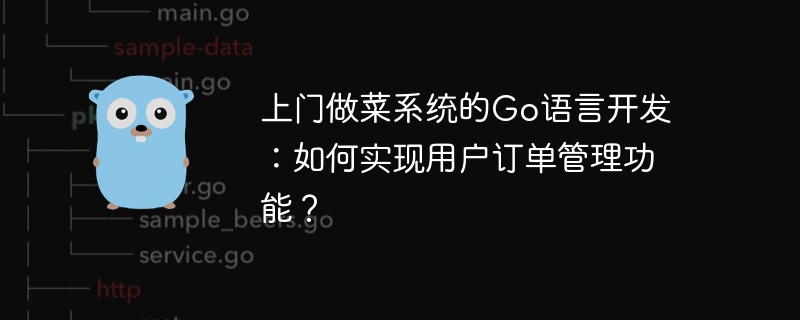Home >Backend Development >Golang >Go language development of door-to-door cooking system: How to implement user order management function?
Go language development of door-to-door cooking system: How to implement user order management function?
- WBOYWBOYWBOYWBOYWBOYWBOYWBOYWBOYWBOYWBOYWBOYWBOYWBOriginal
- 2023-11-01 16:15:191496browse

Go language development of door-to-door cooking system: How to implement user order management function?
With the improvement of people's living standards, more and more families are beginning to choose to enjoy the convenience of home cooking. The ensuing demand has also promoted the development of door-to-door cooking systems. This article will discuss how to implement the user order management function from the perspective of Go language development.
1. Requirements Analysis
Before we start to develop the user order management function, we need to conduct a needs analysis to clarify what functions the system should have. Based on actual needs, user order management can be divided into the following functional points:
- Create order: Users can create new orders through the system and select the required dishes.
- View orders: Users can view their order list and view the order details, including order number, order time, dish name, quantity, amount, etc.
- Cancel orders: Users can cancel uncompleted orders, but they need to pay attention to the time range of cancellation restrictions.
- Evaluate orders: Users can evaluate completed orders and give corresponding scores.
2. Database design
Before implementing the user order management function, we need to design the corresponding database model. Considering that the order needs to save the basic information of the order and the dish information, we can design a structure named "Order", which contains the following fields:
type Order struct {
OrderID int
UserID int
FoodID int
FoodName string
Quantity int
Amount float64
Status int
CreateAt time.Time
UpdateAt time.Time
}Among them, "OrderID" is the order number, and "UserID" is User number, "FoodID" and "FoodName" are the dish number and dish name respectively, "Quantity" is the dish quantity, "Amount" is the order amount, "Status" is the order status, 0 means unfinished, 1 means completed, " CreateAt" and "UpdateAt" are the creation time and update time of the order respectively.
3. Functional implementation
In Go language, you can use the gin framework to quickly develop our door-to-door cooking system. Next, we will implement the user order management function step by step.
- Create order
Users can create orders through the system, and we can define an interface in routing for processing order creation requests. The example is as follows:
func createOrder(c *gin.Context) {
var order Order
if err := c.ShouldBindJSON(&order); err != nil {
c.JSON(http.StatusBadRequest, gin.H{"error": err.Error()})
return
}
// 将订单保存到数据库中
// ...
c.JSON(http.StatusOK, gin.H{"message": "订单创建成功"})
} - View orders
Users can view their order list through the system. We can define an interface for processing order viewing requests. The example is as follows:
func getOrderList(c *gin.Context) {
// 查询数据库获取订单列表
// ...
c.JSON(http.StatusOK, gin.H{"orderList": orderList})
}- Cancel order
Users can cancel unfinished orders. We can define an interface for processing order cancellation requests. The example is as follows:
func cancelOrder(c *gin.Context) {
orderID := c.Param("orderID")
// 查询数据库,判断订单是否可以取消
// ...
// 更新订单状态为取消
// ...
c.JSON(http.StatusOK, gin.H{"message": "订单取消成功"})
}- Evaluate the order
Users can evaluate completed orders. We can define an interface for processing evaluation order requests. The example is as follows:
func rateOrder(c *gin.Context) {
orderID := c.Param("orderID")
rating := c.PostForm("rating")
// 查询数据库,判断订单是否可以评价
// ...
// 更新订单评分
// ...
c.JSON(http.StatusOK, gin.H{"message": "订单评价成功"})
}4. Summary
Through the development of Go language, we can easily implement user order management functions. The above is only a simple sample code. In actual development, it needs to be appropriately improved and optimized according to the actual situation. I hope this article will be helpful to readers who are developing Go language for door-to-door cooking systems.
Reference:
- Gin framework official document: https://gin-gonic.com/
The above is the content of this article, a total of 1500 word.
The above is the detailed content of Go language development of door-to-door cooking system: How to implement user order management function?. For more information, please follow other related articles on the PHP Chinese website!
Related articles
See more- Methods to solve the memory leak optimization problem in Go language development
- Advantages and challenges of developing cross-platform applications using Go language
- How to develop a simple file download function using MySQL and Go language
- Go language development of door-to-door cooking system: How to implement menu recommendation function?
- Go language development of door-to-door cooking system: How to implement user subscription function?

